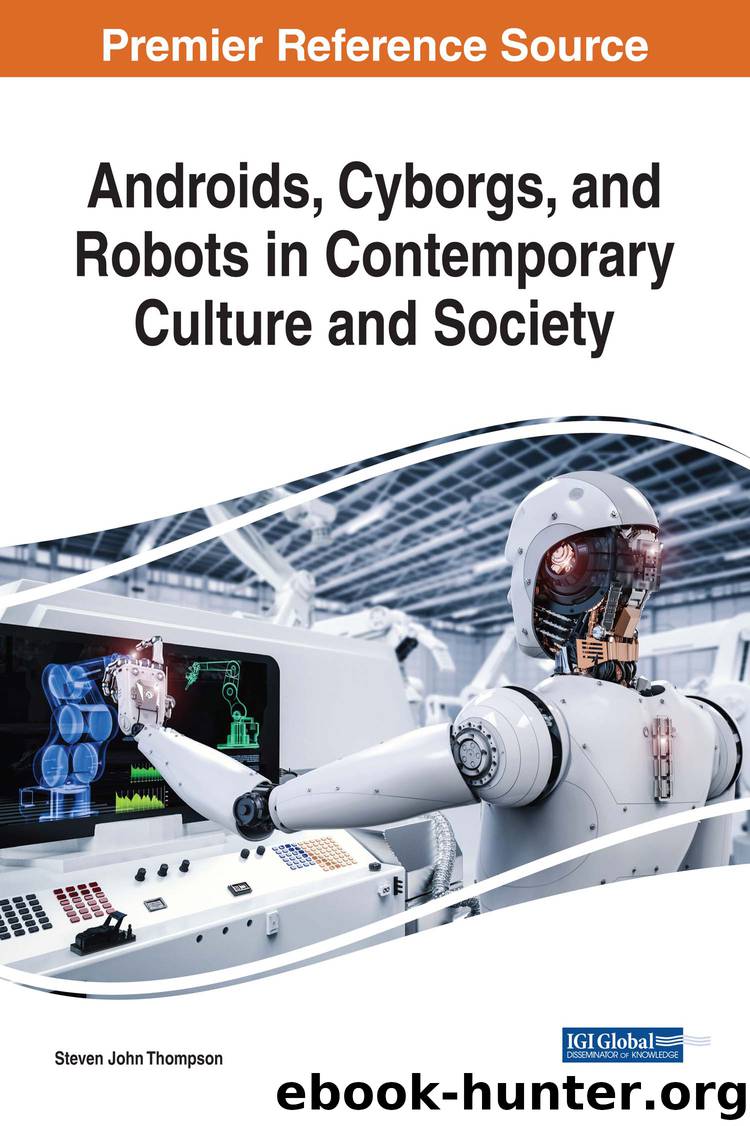Androids, Cyborgs, and Robots in Contemporary Culture and Society by Thompson Steven John

Author:Thompson, Steven John
Language: eng
Format: epub
Publisher: IGI Global
Educators have used Mindstorms robots as a material educational resource for teaching and exploring emergent philosophical questions. Dawson et al. (2010) used Mindstorms in teaching embodied cognitive science, an emerging tradition in examining interplays between thought, bodies, and world. They build their argument partly by presenting designs for Mindstorms robots, and explaining the significance of the behaviours that the designs generate. The performance of the robots provides an implicit critique of classical rationalist cognitive science. The dominant classical model of the mind involves a rule-based cycle of sensing, thinking, and acting, using symbol manipulation. Dawson et al. (2010) argue that much thinking involves more immediate processes of sensing and acting. As this chapter will show, their argument has significant connections with Simondon.
From Bricks to Brains provides detailed instructions on how to build robots that demonstrate non-rule based thought. For example, a robot with light-sensors, motors and wheels demonstrates the dynamics of bodies, light, and space. In one configuration, the robot moves towards a light. By slightly varying the design, the robot moves away from the light. In another configuration, it moves around the light. These complex behaviours emerge not from rule-based rationality, but from small analogue design variations that cause interplays between robot and environment. Complex behaviour proceeds from dynamic relations between the actor and the world, individual and milieu. This emergent complexity of embodied thought implicitly rebuts the dominant rationalist belief that thinking takes place only in the head:
Thinking thus is not viewed as the rational application of logical rules, but is instead viewed as a form of bricolage in which thinkers choose subsets of processes at hand, some sense–think–act and other sense–act, and interact with the world to solve problems. (Dawson et al., 2010, pp. 57-58)
Thinking is not so much a process of symbol manipulation in the brain, than a practice of bricolage — making do with whatever is at hand (Lévi-Strauss, 1966). Learning relies upon the external cognitive scaffolding (1966, p. 73) of the robot to reveal the emergence of complex behaviour in a reactive model. While Lévi-Strauss positioned bricolage as a relatively primitive practice, Dawson et al. (2010) show that, even though it works with limited resources, bricolage has significant power. Even if Mindstorms kits provide only a limited range of pieces, they can still offer a diverse range of experiences. With a manipulable environment and a time and space for experimentation, thinking processes do not work like a disembodied rationalism, but as an embodied practice of bricolage.
Dawson et al. (2010) build a critique of logicism — the belief that rationality is a uniquely human property that takes place in the mind. They argue that the difference between much animal and human intelligence is not a difference in kind. The human mind is not a discrete container for formal thought. In looking at the related question of music, they discuss improvisation, which emerges in real time. Even in classical music, new music compositions do not begin fully formed in the head. Rather, they unfold in a dynamic interplay involving the written score, performers, instruments, audiences, and the room.
Download
This site does not store any files on its server. We only index and link to content provided by other sites. Please contact the content providers to delete copyright contents if any and email us, we'll remove relevant links or contents immediately.
Algorithms of the Intelligent Web by Haralambos Marmanis;Dmitry Babenko(8529)
Test-Driven Development with Java by Alan Mellor(7441)
Data Augmentation with Python by Duc Haba(7331)
Principles of Data Fabric by Sonia Mezzetta(7076)
Learn Blender Simulations the Right Way by Stephen Pearson(7021)
Microservices with Spring Boot 3 and Spring Cloud by Magnus Larsson(6837)
RPA Solution Architect's Handbook by Sachin Sahgal(6252)
Hadoop in Practice by Alex Holmes(6039)
The Infinite Retina by Robert Scoble Irena Cronin(5954)
Jquery UI in Action : Master the concepts Of Jquery UI: A Step By Step Approach by ANMOL GOYAL(5878)
Big Data Analysis with Python by Ivan Marin(5744)
Life 3.0: Being Human in the Age of Artificial Intelligence by Tegmark Max(5410)
Pretrain Vision and Large Language Models in Python by Emily Webber(4702)
Infrastructure as Code for Beginners by Russ McKendrick(4484)
WordPress Plugin Development Cookbook by Yannick Lefebvre(4213)
Functional Programming in JavaScript by Mantyla Dan(4129)
The Age of Surveillance Capitalism by Shoshana Zuboff(4126)
Embracing Microservices Design by Ovais Mehboob Ahmed Khan Nabil Siddiqui and Timothy Oleson(4005)
Applied Machine Learning for Healthcare and Life Sciences Using AWS by Ujjwal Ratan(3981)
